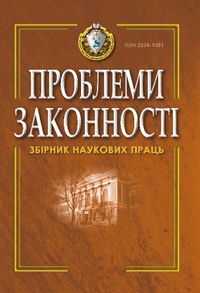Rethinking Regulation: Integrating Large Language Models in International Arbitration
DOI:
https://doi.org/10.21564/2414-990X.166.315451Keywords:
Artificial Intelligence (AI), international arbitration, right to a fair trial, due processAbstract
The article is devoted to the relevant from theoretical and practical points of view issue of using so-called Large Language Models (LLMs) in international arbitration as a type of general-purpose artificial intelligence (AI) aimed at speech recognition and selection of answers with the highest probability, such as ChatGPT, Bildi, Gemini, etc. The purpose of the article is to analyse the challenges arising from the use of LLMs in international arbitration and to develop recommendations for their proper and bona fide application. The article uses the following research methods: the dialectical method (for studying the nature and content of LLMs and the specifics of their application in international arbitration), the method of analysis and synthesis (for analysing and systematising the main challenges of using LLMs in international arbitration), the systemic and structural method (for characterising the right to a fair trial and analysing the specifics of its application in international arbitration), comparative legal method (for examining the provisions of the legislation of certain countries regulating the functioning of international arbitration).Through the prism of the provisions of the United Nations Convention on the Recognition and Enforcement of Foreign Arbitral Awards (1958) and the UNCITRAL Model Law on International Commercial Arbitration (1985), the article examines the main challenges of using LLMs in arbitration, in particular, the need to comply with the requirements of due process and ensure guarantees of the right to a fair trial, the reasoning of arbitral awards, arbitrator impartiality and confidentiality, as well as the right to be heard in arbitration. The authors have analysed specific guidelines on the use of AI in international arbitration in certain institutions, in particular, the Silicon Valley Arbitration and Mediation Center (SVAMC) Guidelines on the Use of AI in Arbitration. This allowed the authors to propose a Checklist for the use of LLMs in international arbitration, which can be applied to the bona fide use of AI in international arbitration proceedings.
References
Florescu, C.I. (2024). The Interaction between AI (Artificial Intelligence) and IA (International Arbitration): Technology as the New Partner of Arbitration. Rom. Arb. J., 18, 42-73.
Vannieuwenhuyse, G. (2018). Arbitration and new technologies: Mutual benefits. Journal of International Arbitration, 35(1), 119-129.
United Nations Commission on International Trade Law. (1958). Convention on the recognition and enforcement of foreign arbitral awards (330 UNTS 3).
United Nations Commission on International Trade Law. (2006). Model law on international commercial arbitration 1985 (with amendments as adopted in 2006). UNGA Res 61/33.
Chan, E., Gore, K.N., & Jiang, E. (2023). Harnessing Artificial Intelligence in International Arbitration Practice. Contemp. Asia Arb. J., 16, 263-300.
Kasap, G.H. (2021). Can Artificial Intelligence (“AI”) replace human arbitrators? Technological concerns and legal implications. J. Disp. Resol., 209-254.
Scherer, M. (2019). Artificial intelligence and legal decision-making: The wide open? Journal of International Arbitration, 36, 539-573.
Council of Europe Convention for the Protection of Human Rights and Fundamental Freedoms (1950).
Komarov, V., Tsuvina T. (2021). The Impact of the ECHR and the Case law of the ECtHR on Civil Procedure in Ukraine. Access to Justice in Eastern Europe, 1(9), 79-101.
Campbell and Fell v. the United Kingdom, 28 June 1984, para 76, Series A no. 80.
Sramek v. Austria, 22 October 1984, para 36, Series A no. 84.
Chevrol v. France, no. 49639/99, para 62-85, ECHR 2003-III.
Van De Hurk v. Netherlands, 19 April 1994, para 45, Series A no. 288.
Benthem v. Netherlands, 23 October 1985, para 40, Series A no. 97.
Tsuvina, T.A. (2015) Right to a Court in Civil Procedure. Kharkiv: Slovo.
Lithgow and others v. the United Kingdom, 08 July 1986, Series A no. 102.
Suovaniemi and Others v. Finland (dec.), no. 31737/96, 23 February 1999.
Porter v. Magill,1 All ER 465. (2002).
Smith, M. L. (2019). The new “real danger” test for arbitrator bias in British Columbia. The Advocate, 77, 847-855.
Partasides, C. (2002). The fourth arbitrator? The role of secretaries to tribunals in international arbitration. Arbitration International, 18, 147-163.
Code de procédure civile (France). (2024), art. 1450.
Arbitration Act (Sweden). (1999), s. 7.
Myanma Yaung Chi Oo Co Ltd v. Win Win Nu, SGHC 124. (2003).
London Court of International Arbitration. (2020). LCIA arbitration rules, art. 30.
Singapore International Arbitration Centre. (2016). SIAC Rules, art. 39.
Dolling-Baker v. Merret, 1 WLR 1205 (1990).
International Coal Pte Ltd v. Kristle Trading Ltd, 1 SLR(R) 945 (2009).
Bantekas, I., Ortolani, P., Ali, S., Gomez, M. A., & Polkinghorne, M. (2020). Form and contents of award. In UNCITRAL Model Law on International Commercial Arbitration: A commentary (pp. 805-830). Cambridge University Press.
Soyak v. Hochtief, NJA 128 (2009).
Silicon Valley Arbitration and Mediation Center. (2024). SVAMC guidelines on the use of artificial intelligence in arbitration.
Laney, D. (2001). 3D data management: Controlling data volume, velocity and variety. META Group Research Note, 6(70).
Downloads
Published
How to Cite
Issue
Section
License
Copyright (c) 2024 Тетяна Цувін, Анна Цувіна

This work is licensed under a Creative Commons Attribution 4.0 International License.










